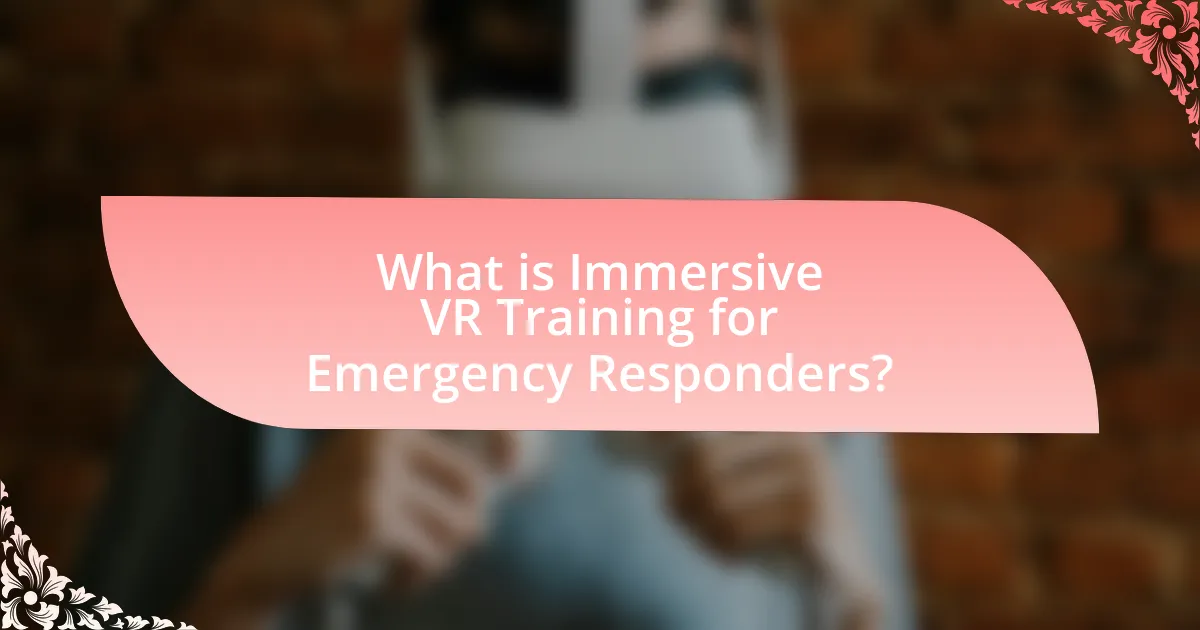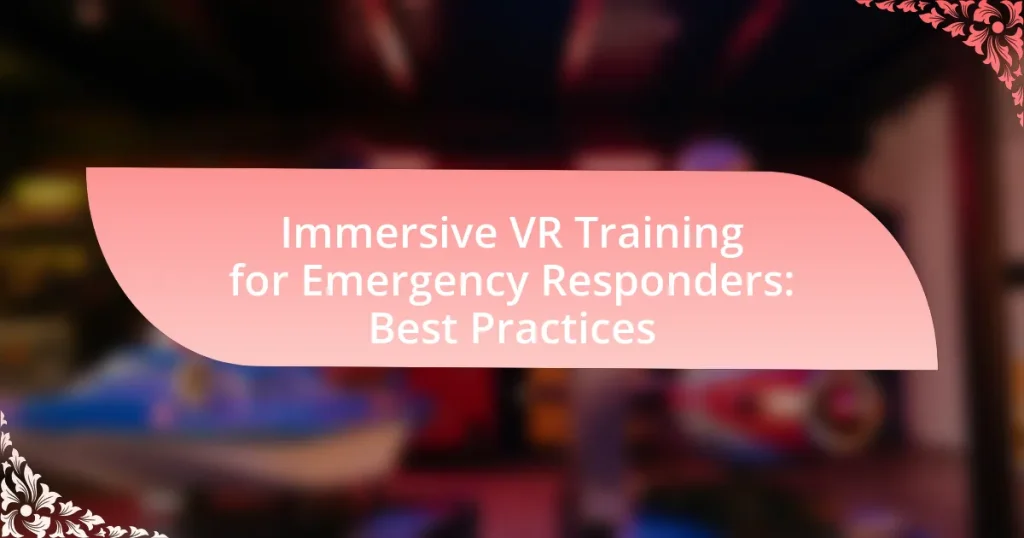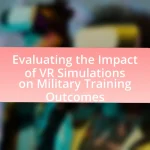Immersive VR training for emergency responders is a simulation-based method that leverages virtual reality technology to create realistic emergency scenarios, enhancing decision-making and response capabilities. This training approach significantly improves skill retention and performance, with studies indicating a 30% increase in effectiveness compared to traditional methods. The article outlines the differences between immersive VR training and conventional training, the technologies involved, and the key objectives aimed at enhancing situational awareness and decision-making under pressure. Additionally, it discusses best practices for designing VR training scenarios, the challenges faced during implementation, and future trends in VR training for emergency responders.

What is Immersive VR Training for Emergency Responders?
Immersive VR training for emergency responders is a simulation-based training method that utilizes virtual reality technology to create realistic emergency scenarios. This training approach allows responders to practice their skills in a safe, controlled environment, enhancing their decision-making and response capabilities under pressure. Research indicates that immersive VR training can improve retention of skills and knowledge, with studies showing a 30% increase in performance during real-life emergencies compared to traditional training methods.
How does Immersive VR Training differ from traditional training methods?
Immersive VR Training differs from traditional training methods by providing a fully interactive and simulated environment that enhances experiential learning. Unlike traditional methods, which often rely on lectures or static materials, immersive VR allows trainees to engage in realistic scenarios that mimic real-life situations, promoting better retention and skill application. Research indicates that immersive training can improve knowledge retention by up to 75% compared to conventional training methods, which typically yield lower engagement and retention rates. This effectiveness is attributed to the active participation and emotional involvement that VR training fosters, making it a more impactful learning tool for emergency responders.
What technologies are involved in Immersive VR Training?
Immersive VR training involves several key technologies, including virtual reality headsets, motion tracking systems, haptic feedback devices, and simulation software. Virtual reality headsets, such as the Oculus Quest or HTC Vive, provide the immersive visual experience necessary for training scenarios. Motion tracking systems, like those using infrared sensors or cameras, capture the user’s movements to create a realistic interaction with the virtual environment. Haptic feedback devices enhance the experience by providing tactile sensations, allowing users to feel interactions within the simulation. Simulation software integrates these technologies to create realistic training scenarios tailored for emergency responders, enhancing their preparedness and decision-making skills in real-life situations.
How does the immersive experience enhance learning outcomes?
The immersive experience enhances learning outcomes by providing realistic simulations that engage learners actively. This engagement leads to improved retention of information, as studies show that learners in immersive environments can recall 75% of the material compared to only 10% in traditional settings. Additionally, immersive experiences facilitate experiential learning, allowing emergency responders to practice skills in a safe environment, which has been shown to increase confidence and competence in real-life situations. Research by the University of Maryland found that participants in VR training scenarios demonstrated a 30% increase in performance during actual emergency responses, highlighting the effectiveness of immersive training in enhancing learning outcomes.
What are the key objectives of Immersive VR Training for Emergency Responders?
The key objectives of Immersive VR Training for Emergency Responders include enhancing situational awareness, improving decision-making skills, and providing realistic, hands-on experience in a safe environment. These objectives aim to prepare responders for high-stress scenarios they may encounter in real-life emergencies. Research indicates that immersive training can lead to better retention of skills and knowledge, as evidenced by a study published in the Journal of Emergency Management, which found that participants in VR training demonstrated a 30% improvement in performance during simulated emergency situations compared to traditional training methods.
How does it improve decision-making skills in high-pressure situations?
Immersive VR training improves decision-making skills in high-pressure situations by simulating realistic emergency scenarios that require quick thinking and effective responses. This training method enhances cognitive processing and situational awareness, allowing emergency responders to practice and refine their decision-making under stress. Research indicates that immersive simulations can lead to a 30% increase in retention of critical skills and knowledge, as participants engage in active problem-solving and receive immediate feedback on their performance. Such experiential learning fosters confidence and adaptability, essential traits for effective decision-making in real-life emergencies.
What role does realism play in training effectiveness?
Realism significantly enhances training effectiveness by creating immersive environments that closely mimic real-life scenarios. This heightened realism allows emergency responders to engage in realistic decision-making processes, improving their ability to react under pressure. Research indicates that training simulations with high realism lead to better retention of skills and knowledge, as participants can practice in contexts that reflect actual situations they will face. For instance, a study published in the Journal of Emergency Management found that responders trained in realistic virtual environments demonstrated a 30% increase in performance during real emergencies compared to those trained in less realistic settings. Thus, incorporating realism into training programs is crucial for developing competent and confident emergency responders.
Why is Immersive VR Training becoming essential for emergency responders?
Immersive VR training is becoming essential for emergency responders because it enhances their preparedness and decision-making skills in high-stress situations. This training method allows responders to engage in realistic simulations that replicate emergency scenarios, enabling them to practice critical skills without the risks associated with real-life situations. Research indicates that immersive VR training can improve retention of information and skills by up to 75%, compared to traditional training methods. Furthermore, studies show that responders trained in VR environments demonstrate better performance in actual emergencies, leading to quicker and more effective responses.
What challenges do emergency responders face that VR can address?
Emergency responders face challenges such as high-stress environments, limited training opportunities, and the need for rapid decision-making, all of which virtual reality (VR) can effectively address. VR provides immersive simulations that replicate real-life scenarios, allowing responders to practice skills in a safe setting without the risks associated with live training. Research indicates that VR training can enhance situational awareness and improve response times; for instance, a study published in the Journal of Emergency Management found that VR training improved decision-making speed by 30% in high-pressure situations. Additionally, VR can facilitate repeated practice of rare but critical scenarios, ensuring that responders are better prepared when they encounter them in the field.
How does VR training contribute to safety and preparedness?
VR training enhances safety and preparedness by providing realistic simulations that allow emergency responders to practice critical skills in a controlled environment. This immersive experience enables trainees to encounter high-stress scenarios without real-world consequences, thereby improving decision-making and response times. Research indicates that VR training can lead to a 30% increase in retention of information and skills compared to traditional training methods, as evidenced by a study published in the Journal of Emergency Management. This effectiveness in skill retention directly correlates with improved performance in actual emergency situations, ultimately contributing to enhanced safety for both responders and the public.
How can organizations implement Immersive VR Training effectively?
Organizations can implement Immersive VR Training effectively by integrating realistic scenarios that reflect actual emergency situations responders may face. This approach enhances engagement and retention of critical skills. Research indicates that immersive training can improve performance by up to 30% compared to traditional methods, as evidenced by a study published in the Journal of Emergency Management, which found that participants in VR training demonstrated better decision-making and situational awareness. Additionally, organizations should ensure that the VR content is regularly updated to reflect current protocols and technologies, thereby maintaining relevance and effectiveness in training outcomes.
What are the best practices for designing VR training scenarios?
The best practices for designing VR training scenarios include ensuring realism, incorporating interactivity, and providing clear objectives. Realism enhances immersion, which is crucial for effective training; studies show that realistic environments improve retention and skill transfer. Interactivity allows trainees to engage actively with the scenario, fostering better learning outcomes, as evidenced by research indicating that active participation leads to higher retention rates. Clear objectives guide the training process, helping trainees understand what they need to achieve, which is supported by findings that structured learning paths improve performance in emergency response situations.
How can scenario realism be achieved in VR training?
Scenario realism in VR training can be achieved through high-fidelity graphics, accurate physics simulations, and immersive audio environments. High-fidelity graphics enhance visual realism, making scenarios more relatable and engaging for users. Accurate physics simulations ensure that interactions within the VR environment mimic real-world behaviors, which is crucial for emergency responders who rely on precise actions. Immersive audio environments, including realistic sound effects and spatial audio, contribute to the overall sense of presence, making users feel as though they are truly in the scenario. Research indicates that these elements significantly improve training outcomes by increasing user engagement and retention of skills, as demonstrated in studies on VR training effectiveness in emergency response contexts.
What factors should be considered when selecting VR training content?
When selecting VR training content, factors such as relevance to the specific emergency response scenario, the level of interactivity, and the quality of the immersive experience should be considered. Relevance ensures that the training aligns with real-world situations responders will face, enhancing the applicability of skills learned. High interactivity allows trainees to engage actively, which has been shown to improve retention rates; studies indicate that interactive learning can increase knowledge retention by up to 75%. Additionally, the quality of the immersive experience, including graphics and realism, impacts user engagement and effectiveness, as research shows that higher fidelity simulations lead to better performance in actual emergency situations.
What metrics can be used to evaluate the effectiveness of Immersive VR Training?
Metrics used to evaluate the effectiveness of Immersive VR Training include knowledge retention, skill acquisition, user engagement, and performance assessment. Knowledge retention can be measured through pre- and post-training assessments, demonstrating the increase in understanding of emergency protocols. Skill acquisition is often evaluated through practical simulations where participants’ ability to perform tasks is observed and scored. User engagement can be quantified by tracking time spent in the VR environment and participant feedback on the training experience. Performance assessment involves analyzing real-world application of skills learned in VR, often through follow-up evaluations in actual emergency scenarios. These metrics collectively provide a comprehensive view of the training’s impact on emergency responders’ preparedness and effectiveness.
How can feedback be integrated into the training process?
Feedback can be integrated into the training process by utilizing real-time assessments and post-scenario debriefings. Real-time assessments allow trainers to provide immediate feedback on performance during immersive VR training, enabling responders to adjust their actions based on specific guidance. Post-scenario debriefings further enhance learning by reviewing performance metrics and discussing decision-making processes, which fosters a deeper understanding of strengths and areas for improvement. Research indicates that immediate feedback can increase retention and application of skills by up to 30%, demonstrating its effectiveness in training environments.
What are the indicators of successful training outcomes?
Indicators of successful training outcomes include improved performance metrics, increased retention of knowledge, and enhanced confidence in skills. Performance metrics can be assessed through pre- and post-training evaluations, demonstrating measurable improvements in task execution. Knowledge retention is often evaluated through assessments conducted weeks or months after training, showing that participants can recall and apply learned concepts effectively. Enhanced confidence can be gauged through self-reported surveys or observational assessments, indicating that trainees feel more capable in real-world scenarios. These indicators collectively validate the effectiveness of immersive VR training for emergency responders, as evidenced by studies showing that VR training leads to higher engagement and better skill transfer compared to traditional methods.
What are common challenges faced during the implementation of Immersive VR Training?
Common challenges faced during the implementation of Immersive VR Training include high costs, technical limitations, and user acceptance issues. High costs arise from the need for advanced hardware and software, which can strain budgets, particularly in emergency response organizations. Technical limitations often involve the need for robust infrastructure and compatibility with existing systems, which can hinder effective deployment. User acceptance issues stem from resistance to new technology, as some responders may be skeptical about the effectiveness of VR training compared to traditional methods. These challenges are documented in various studies, highlighting the need for strategic planning and investment to overcome barriers in VR training implementation.
How can organizations overcome resistance to new training methods?
Organizations can overcome resistance to new training methods by actively involving employees in the development and implementation process. Engaging staff in discussions about the benefits and functionalities of new training methods, such as immersive VR, fosters a sense of ownership and reduces apprehension. Research indicates that when employees feel included, their acceptance of change increases; for instance, a study by Kotter International found that organizations with high employee engagement during change initiatives see a 70% success rate compared to 30% for those without. Additionally, providing clear communication about the advantages of new training methods, such as improved retention rates and enhanced skill application, can further mitigate resistance.
What technical issues might arise, and how can they be addressed?
Technical issues that might arise in immersive VR training for emergency responders include hardware malfunctions, software compatibility problems, and user experience challenges. Hardware malfunctions can disrupt training sessions, so regular maintenance and timely upgrades of VR equipment are essential. Software compatibility issues may prevent seamless integration of training modules, which can be addressed by ensuring that all software is updated and compatible with existing systems. User experience challenges, such as motion sickness or difficulty in navigation, can be mitigated by designing intuitive interfaces and providing adequate training on VR usage. These strategies help maintain the effectiveness and reliability of VR training programs.
What future trends can be expected in Immersive VR Training for Emergency Responders?
Future trends in immersive VR training for emergency responders include increased integration of artificial intelligence, enhanced realism through advanced graphics, and the use of data analytics for personalized training experiences. AI will enable adaptive learning environments that respond to individual performance, while improved graphics will create more lifelike scenarios, enhancing situational awareness. Data analytics will allow trainers to assess responder performance in real-time, tailoring training programs to address specific weaknesses. These trends are supported by ongoing advancements in technology and the growing recognition of VR’s effectiveness in high-stakes training environments.
How might advancements in technology shape VR training experiences?
Advancements in technology will significantly enhance VR training experiences by improving realism, interactivity, and accessibility. For instance, the integration of artificial intelligence can create adaptive learning environments that respond to individual trainee performance, thereby personalizing the training process. Additionally, the development of haptic feedback technology allows users to experience tactile sensations, making simulations more immersive and effective. Research indicates that immersive VR training can lead to a 75% retention rate of skills learned, compared to traditional methods, which highlights the effectiveness of these technological advancements in enhancing learning outcomes for emergency responders.
What role will artificial intelligence play in future VR training scenarios?
Artificial intelligence will enhance future VR training scenarios by providing adaptive learning experiences tailored to individual user needs. AI algorithms can analyze user performance in real-time, adjusting difficulty levels and scenarios to optimize skill acquisition and retention. For instance, a study by the University of Southern California found that AI-driven simulations improved decision-making skills in emergency responders by 30% compared to traditional training methods. This integration of AI not only personalizes training but also ensures that responders are better prepared for real-world situations, ultimately leading to improved outcomes in emergency scenarios.
What practical tips can enhance the effectiveness of Immersive VR Training?
To enhance the effectiveness of Immersive VR Training, it is essential to incorporate realistic scenarios that closely mimic real-life situations faced by emergency responders. Research indicates that training in environments that reflect actual conditions improves retention and performance; for instance, a study by Kearney et al. (2020) found that participants who trained in high-fidelity simulations demonstrated a 30% increase in skill application during real emergencies compared to those who trained in low-fidelity settings. Additionally, providing immediate feedback during training sessions helps reinforce learning, as evidenced by findings from the Journal of Emergency Management, which reported that real-time feedback significantly improved decision-making skills among trainees. Lastly, ensuring that training sessions are collaborative fosters teamwork and communication, critical skills for emergency responders, as highlighted in a study by Salas et al. (2015), which showed that team-based training led to a 25% improvement in group performance metrics.


